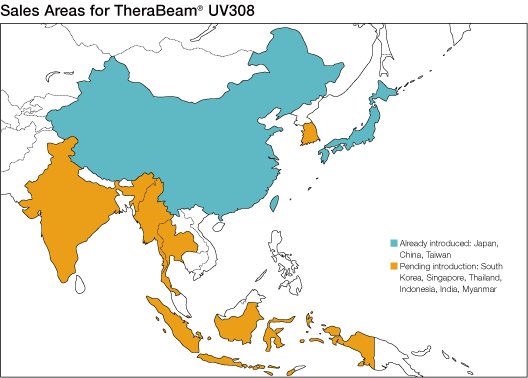Are you familiar with autoimmune diseases? These ailments are considered a type of allergic reaction, and many people suffer from them. With autoimmune diseases, instead of attacks by outside bacteria, viruses and other microbes, a person’s own normally protective immune cells (white blood cells) suddenly begin to attack the body itself, causing symptoms to emerge. Therapeutic approaches that use light have had great success in combating these illnesses.
Some Commonly Known Illnesses Are Allergies
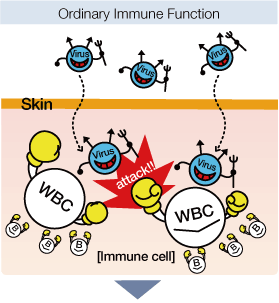
Hay fever, hives and atopic skin inflammation are all commonly known allergic reactions. In recent years, however, a whole spectrum of illnesses and conditions are now known to actually be types of allergic reactions referred to as autoimmune diseases. These include conditions once classed as skin ailments, such as vitiligo, psoriasis, alopecia areata (autoimmune hair loss), and palmoplantar pustulosis (a form of psoriasis affecting the palms and soles of the feet), to conditions with vastly different symptoms, such as rheumatoid arthritis.
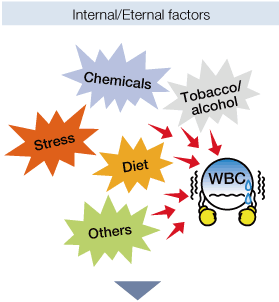
But why should what is basically an allergic reaction (autoimmune diseases) trigger so many illnesses that at first glance appear to be completely unrelated disorders sharing virtually none of the same symptoms? The reason for this is that when white blood cells, which normally protect the body, become overactive, they mistakenly begin to attack the body’s own cells.
Attack on Friendly Cells by White Blood Cells
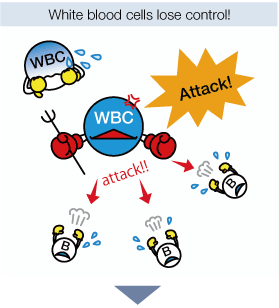
Vitiligo is thought to afflict some 100,000 people in Japan. In this condition, white blood cells lose control and begin attacking melanocytes, the cells that produce pigment for the skin. The attack causes these cells to lose their functionality and to stop making pigment, leading to the condition’s telltale symptoms. Similar attacks on the cells that make up hair follicles in alopecia areata (autoimmune hair loss) and the synovial membrane of the joints in rheumatoid arthritis are the mechanism behind the symptoms associated with these disorders.
UV Phototherapy to Treat Skin Allergies
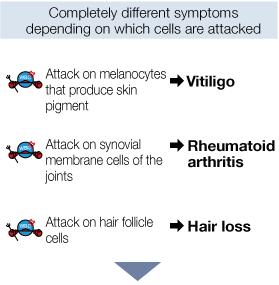
Until recently, skin allergy ailments were treated mostly with prescription medication or topical agents. However, concern arose over the limited effectiveness of these approaches, which was often accompanied by unpleasant side effects. UV phototherapy has thus been drawing increasing interest in recent years.
Two Mechanisms behind UV Phototherapy
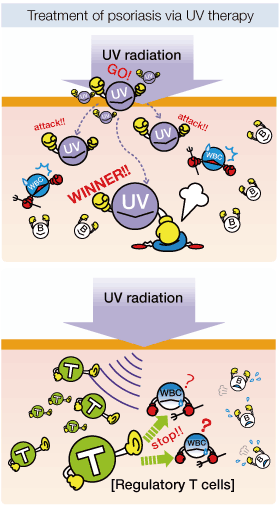
Taking one type of skin allergy, psoriasis, as an example, there are two mechanisms behind how UV phototherapy works. The first is the destruction of the overactive white blood cells, the direct cause of the condition. The second involves increasing the number of a different set of white blood cells, called regulatory T cells, that help deactivate their trouble-causing counterparts. In other words, UV radiation has an immune suppressing effect that reduces the number and attack strength of white blood cells that have begun attacking the body’s own cells, thereby mitigating the symptoms.
The Key Is Wavelength
All UV light is not the same, however, when it comes to phototherapy. Indeed, it is widely known that UV light contains components that can be harmful to living tissue. As a result, there was a need for a phototherapy device that was safe and easy to use, and could stably bathe an affected area solely in wavelengths of UV that would enhance therapeutic effectiveness while minimizing any side effects.
The purpose of this information is to intuitively explain general medical information to a broad audience; it is not intended as a testimonial of effectiveness.
All for the Sake of Patients: ‘Phototherapy and Excimer Filters’
Phototherapy utilizes the immune-suppressing effects of UV light to quell skin symptoms arising from an excessive immune response. Since the 1970s, when researchers at Harvard University discovered that UV radiation could effectively treat psoriasis, UV light in the 311-nanometer (nm) band has been the most commonly used wavelength for treatment.
In fact, though, the approximate effectiveness of a particular wavelength and its potential side effects had largely remained a mystery, and while the existence of relatively more effective wavelengths was suggested, the research did not extend to determining which specific wavelengths had a strong effect.
Identifying Light with Greater Therapeutic Effectiveness and Fewer Side Effects
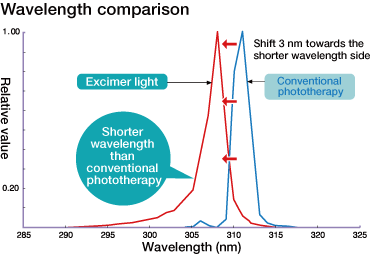
A joint research team from USHIO and the Nagoya City University Department of Geriatric and Environmental Dermatology (Prof. Akimichi Morita) decided to tackle the challenge of identifying the optimal treatment. In searching for light that would enhance therapeutic effectiveness with fewer side effects, the team concluded after a detailed analysis of wavelengths that the most effective light is at a wavelength of 308 nm, where effectiveness peaks. They also determined that cutting wavelengths below 297 nm reduced skin redness and other side effects.
While just 3 nm shorter than the 311-nm wavelength conventionally used, there were now grounds to expect that this previously unidentified wavelength could eventually make more effective therapy possible.
Original Excimer Filter Based on Light Technology
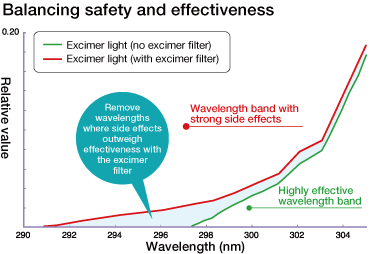
The same research team applied their findings to an excimer lamp, a product that USHIO led the world in commercializing in the 1970s. The team developed a light source to emit peak 308-nm wavelength, a technologically impossible task when the lamp was first marketed. The team also successfully developed an excimer filter to block short wavelengths below 297- nm, which were associated with the biggest side effects.
Based on the excimer light, in 2008, USHIO created a working phototherapy device equipped with its own proprietary light technology, making safe and highly effective phototherapy a reality. This was the birth of the TheraBeam® UV308, the world’s first device of its kind to have both a 308-nm excimer light and excimer filter.
Kobayashi K, Morita A et al, Photoderm Photoimmunol Photomed 25; 30-36, 2009
From Japan to the World
Since its launch, the outstanding safety and effectiveness of the TheraBeam® UV308 for dermatological use has earned the device a strong reputation among dermatologists and patients alike. Today, the TheraBeam® UV308 boasts the top share of the market in Japan (based on USHIO data). The device has already won approval for medical use in China and Taiwan, where it is now being sold. USHIO now plans to obtain similar approval and promote sales in South Korea, India and other markets in Asia, as well as in the United States, Europe and elsewhere around the world. These products will enable both the light field and the position of the device to be selected more easily depending on the size and location of the target area of the body.
